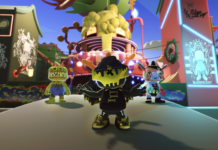Indulge me for a moment here. I am of a small group of people that has spent almost forty hours with The Old Republic, Bioware’s MMO based upon the Star Wars universe. Every hour with the game has been entirely addictive and entertaining. I’ve quested as a Sith Warrior, talked down to NPCs as a Jedi Consular, and walked the fine line between good and bad as a bounty hunter. With this much time invested in the game, you’d think I’d be tired of it. But I’m not.
Understand this: I don’t care about Star Wars that much. MMOs have always been an exercise in frustration for me. Hell, I’ve yet to beat a BioWare game. But BioWare Austin has done a fantastic job maintaining my interest in what may be one of the best games of the year (should they reach their goal of a 2011 release).

For those new to The Old Republic, this is Star Wars 3,000 years before Darth Vader came onto the scene. The battles between the dark and the light sides of the force are just as intense, and players constantly have to interact with their place in the galaxy.
At its core, The Old Republic is an MMO in the same vein as World of Warcraft. Players can fulfill traditional MMO roles, such as healer, tank, or DPS-focused character, and they can do it with each of the eight classes and multitude of humanoid races. This time, BioWare showed off the Bounty Hunter and the Imperial Agent.

The Imperial Agent is a unique class, one I have never seen before in an MMO. They are cover-based, stealth/rogue class, meaning they can hide behind specially marked cover points and use a rifle against enemies. They can also sneak behind other characters for the kill. The Imperial Agents are interesting in that they are basically the James Bond class of The Old Republic. Their ship is a sleek and silver spaceship, closer to a knife than a traditional ship. This character’s starter world, Hutta, is singular in that the Imperial Agent starts off as an American-accented character trying to help the Hutts, when in fact he’s a British-accented undercover agent. Unfortunately, I did not spend any time with this character full hands-on.
I was given much more time with the Bounty Hunter class. The Bounty Hunter also starts out on Hutta, but their goals are much different than the Imperial Agent. Instead of working outright for the Sith Empire, they work for themselves. Sure, they can be evil jackasses for the sake of money and attention, but they can also work for good. The lead writer for The Old Republic, Daniel Ericsson, indicated that the Bounty Hunter is fairly neutral on the Empire side, and there might be a class on the Galactic Republic that will be as ambiguously good or bad.

I spent a solid 16 hours with my Bounty Hunter, a thin man named Allor. Beginning on the polluted world of Hutta, Allor’s missions ultimately revolved around escaping the polluted and muddy swamp world to take part in a massive hunt. This hunt is tasked to the character until something nasty happens, and then things become a lot more complicated. I won’t delve too far into the details, but let’s just say that Allor spends a long time earning allegiances and money. Two warring Hutts provide the backbone for most of the missions, and I played my bounty hunter as a money-obsessed jerk.
After nearly two days of killing traitors, fulfilling bounties, and helping less savory characters finish their own duties, I worked my way off Hutta to the planet of Dromund Kaas, where the hunt was set to take place. Dromund Kass is a very damp jungle capital world. It’s always dark, but the Sith have made themselves very comfortable there. Missions about killing jungle animals, assisting fellow bounty hunters, and diffusing bombs remain the raison d’etre of this planet. Unfortunately, I had to leave that business behind so I could go on the actual hunt, but I’m looking forward to rolling a bounty hunter of my own in the future.

The Bounty Hunter, unlike the Imperial Agent, is a little easier to grasp. They can use missals, flamethrowers, pistol shots, and even a melee attack that looks like a dragon punch. Their role is much more DPS- and Tank-focused, although they do need to keep their distance from enemies. Once an enemy charges forward, the Bounty Hunter will struggle a bit. Additionally, all of their attacks are heat-based, so instead of mana, the Bounty Hunter has to make sure his suit doesn’t overheat.
At level 10 the Bounty Hunter can gain some new skills. At this point players can specialize their class. Every class has two specializations, and the Bounty Hunter’s divide them into the defense-heavy Powertech or the offensive Mercenary. I chose the Mercenary, letting my character dual-wield pistols and generally deal more damage. Once a character has switched to their specialization, players can then spend points on three trees under it. In this way The Old Republic addresses traditional MMO roles, as these tech trees modify each of the classes to furnish specific Tank/Healer/etc roles.

Early on, I was introduced to my first companion. As with any BioWare game, companions will be a common feature. Major decisions on the part of the player will strongly impact the character’s good/evil dichotomy, but less serious character interactions will instead impact how a character views you. The Bounty Hunter’s first companion is Mako, a positive and smart human assistant with a naïve spirit. She’s obviously a potential romance companion, and her role in battle is either that of a support healer for your character or a traditional damage-dealing bounty hunter. She’s interesting, spunky, and ready for action and to do what’s right. Considering this all comes from the “bad” side of Star Wars, it’s nice to see some complexity in the game’s narrative.
Companions do raise one weird problem in the game: they’re everywhere. For a game that offers justification for almost everything in a believable manner, the fact that, especially in the early levels, are loads of Makos running around is a little weird. This becomes less of a problem once the companions have been gifted items and equipment, but their plurality is still a little odd.

The Bounty Hunter’s ship is also very different than the Imperial Agent’s. Inspired by Boba Fett’s ship and the Serenity ship from Firefly, the Bounty Hunter’s ship is a beast, coming two massive stories tall. We’re talking the size of the Normandy in Mass Effect. Like in Mass Effect, companions will rest here between missions and interact with each other, and the whole ship acts as a hub for the player. Companions do much of the crafting, so those left on the ship can spend their time making items for use. Other gamers can visit the ship as well, which will evolve as players progress through the storyline. The ship is very important, but that doesn’t even begin to cover the ship flying missions.
In one area, which could be very good or very bad, players take control of their ship and fly around a la on-rails shooting in space. It looks like fun but seems unnatural, even though the game is part of a franchise designed around space fights. I hope BioWare does an awesome job with this element of the game, but if not, it won’t ruin the larger experience.

Lastly, this is an MMO. I’ll discuss the PvP element of the game another day, but group-based PvE is still very important. The Old Republic has a few unique problems, and they mostly deal with the story elements of the game. Say a duo of Bounty Hunters team up. When they perform story missions, sometimes the game puts up a massive green barrier. When they cross this barrier, it means that only one of the Bounty Hunters can partake in that mission, instantly separating the players until they regroup after the mission element. This is a result of the team-based conversation trees. Players will enter a conversation, and an NPC will talk to them all. Each player makes a response, and the game rolls to find out who will get to speak. There’s a conflict when two characters of the same type, doing the same story stuff, come together. It’s a little weird, but it makes sense in the end.
While the game can be played together at any moment, there are two areas where it is especially important to team up. First: heroic missions. These missions are particularly difficult on one’s own, but they are much easier to beat once players have grouped up. The other area that requires group play are the Flashpoints. These are group-based missions that are much more self-contained. Up to four players—and four players alone—can play through these missions. Typically, when players work in teams, each player controls himself and a companion. In Flashpoints, companions will only be around if fewer than three players are involved.

However, once a group enters a Flashpoint, the event tends to be exciting. Our Flashpoint regarded a mutinous Empire ship, and player decisions included killing or forgiving the mutinous group, finding and destroying items, searching for a traitor, and defeating a Padawan jedi. These missions are very satisfying, offer loads of experience and decent loot, and provide a great way to pad out a character when the game’s difficulty becomes intense.
Star Wars: The Old Republic is an incredibly compelling and enjoyable game. In its current state, BioWare, EA, and LucasArts could send it out to players and turn on servers immediately and the game would be well worth $15 a month. Hopefully we can get impressions of the final product soon, and with a prospective 2011 release date, we may have The old Republic in our hands before the year is up.










